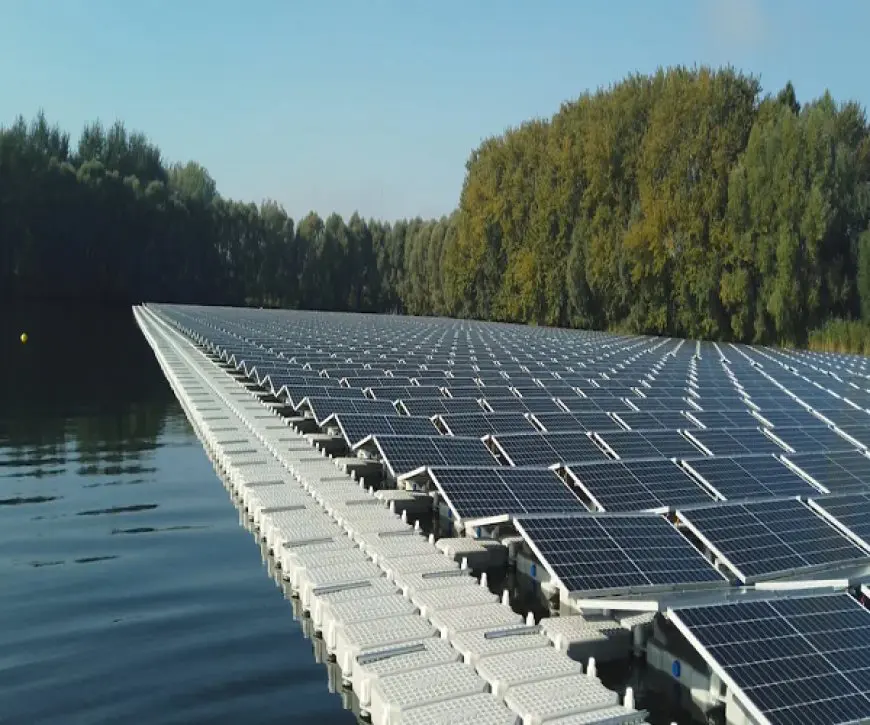Floating Solar Panels Market 2025-2034: Growth, Trends, and Forecast
The floating solar panels market is emerging as a game-changer in renewable energy, offering solutions for land-scarce regions and reducing the environmental footprint of traditional solar. Learn about the market's growth, trends, and key players in this revolutionary sector.

The global Floating Solar Panels Market is experiencing significant growth, with a projected value increase from USD 3.37 billion in 2024 to USD 40.07 billion by 2035. This represents a remarkable Compound Annual Growth Rate (CAGR) of 25.24% over the period from 2025 to 2035.
The Floating Solar Panels Market is witnessing a rapid rise as one of the most innovative and sustainable solutions for renewable energy generation. Floating solar panels, also known as "floatovoltaics," are photovoltaic systems that are mounted on bodies of water such as reservoirs, lakes, or even oceans. These systems are emerging as an alternative to traditional land-based solar panels, offering several benefits, including the efficient use of water surfaces and the ability to reduce water evaporation. The market for floating solar panels is primarily driven by the global push for renewable energy, the increasing demand for energy-efficient solutions, and the limited availability of land for large-scale solar installations. Additionally, governments and organizations worldwide are providing incentives to promote renewable energy adoption, which is further fueling market growth. As technological advancements in floating solar panels continue, this market is poised for significant growth in the coming years.
Get Access to A Sample Report with List of TOC, Charts, Figures @ https://www.vantagemarketresearch.com/floating-solar-panels-market-0846/request-sample
Market Dynamics
The Floating Solar Panels Market is experiencing a dynamic transformation, driven by various factors that enhance its adoption across different regions. One of the key drivers is the growing need for clean and sustainable energy solutions due to the global shift toward reducing carbon emissions. As governments implement policies aimed at achieving net-zero emissions, renewable energy solutions such as floating solar panels are becoming increasingly vital. Furthermore, floating solar panels offer advantages such as reduced land usage and the potential for generating power in water-scarce areas, especially where land is limited or unsuitable for traditional solar farms.
Technological innovations also play a crucial role in market dynamics. The development of more efficient and durable floating solar panels, as well as improved materials and installation methods, are boosting market demand. These advancements are expected to drive down installation costs while improving overall performance. The growing awareness of the environmental benefits of floating solar panels, including their ability to enhance water quality and reduce evaporation, is also contributing to their adoption.
However, certain challenges persist, such as high initial costs and the need for specialized infrastructure, which may restrict market growth in some regions. Nevertheless, with increasing investment and research into making floating solar panels more cost-effective, the market is expected to expand rapidly.
Competitive Landscape
- Ciel & Terre International
- Hanwha Group
- JA SOLAR Technology Co. Ltd
- KYOCERA Corp
- LONGi Solar
- Trina Solar
- Vikram Solar Ltd
- Wuxi Suntech Power Co. Ltd
- Yellow Tropus Pvt. Ltd
- Yingli Solar
Don’t miss out on this exclusive opportunity, enjoy a 25-35% discount @ https://www.vantagemarketresearch.com/buy-now/floating-solar-panels-market-0846/0
Top Trends in the Floating Solar Panels Market
Several trends are emerging in the Floating Solar Panels Market that are shaping the future of the renewable energy industry. One prominent trend is the increasing integration of floating solar systems with other renewable energy sources. Hybrid systems that combine floating solar panels with offshore wind farms or hydropower plants are gaining traction, as they offer the potential for more efficient energy generation. This trend is driven by the desire to optimize energy production in water-rich areas, where both solar and wind resources can be harnessed simultaneously.
Another significant trend is the growing focus on the development of large-scale floating solar farms. Countries with limited land space, such as Japan, South Korea, and China, are investing heavily in these projects to meet their energy needs while minimizing land usage. These large-scale farms are expected to contribute significantly to global renewable energy targets in the coming decades.
Moreover, the advancement of floating solar panel technology is making them more adaptable to diverse environmental conditions. For instance, new designs are being developed to withstand extreme weather conditions and to be more easily integrated into various bodies of water. As these technological improvements continue, the cost of installation is expected to decrease, making floating solar panels more accessible to a wider range of users, from governments to private companies.
Segmentation Insights:
By Capacity
- Below 5MW
- 5MW – 50MW
- Above 50MW
By Type
- Stationary Floating Solar Panels
- Tracking Floating Solar Panels
Purchase This Premium Report Now @ https://www.vantagemarketresearch.com/buy-now/floating-solar-panels-market-0846/0
Challenges
Despite the promising growth of the Floating Solar Panels Market, several challenges are hindering its widespread adoption. One of the primary challenges is the high initial installation cost associated with floating solar systems. Although the cost of solar panels has decreased in recent years, the unique infrastructure required to install floating solar panels, including anchoring systems and specialized pontoons, remains expensive. This can deter smaller businesses and municipalities from pursuing floating solar projects, especially in developing countries where budgets are limited.
Another challenge is the lack of regulatory clarity and the complex permitting process for installing floating solar farms. As floating solar technology is relatively new, there are often regulatory barriers that need to be overcome, such as environmental impact assessments and navigational concerns. Additionally, some bodies of water may be located in areas with strict zoning laws or competing interests, such as fishing or recreational activities, which can further complicate the approval process.
Finally, the maintenance of floating solar panels can be more challenging than traditional land-based systems. Factors such as water salinity, algae growth, and fluctuations in water levels can impact the performance and longevity of the panels. This increases the operational and maintenance costs associated with floating solar installations, which could deter some potential investors.
Opportunities
Despite the challenges, the Floating Solar Panels Market presents numerous opportunities for growth. The most significant opportunity lies in the global transition toward clean energy. With countries around the world setting ambitious renewable energy targets, floating solar panels are poised to play a crucial role in helping governments meet these goals. In regions where land availability is limited, floating solar panels provide a viable solution that can help countries tap into previously unused water surfaces.
Additionally, the ongoing research and development in floating solar technologies present substantial opportunities. Innovations that reduce the cost of installation, improve the durability of panels, and make maintenance easier will likely unlock new markets and expand the adoption of floating solar systems. Furthermore, the increasing awareness of climate change and the need for sustainable energy sources is driving demand for floating solar solutions, particularly in regions with high levels of solar radiation and water bodies.
As floating solar technology becomes more cost-competitive, opportunities for large-scale projects, particularly in developing countries, will increase. Investment in infrastructure, such as energy storage systems and grid integration technologies, will also create new opportunities for companies to participate in the growth of this market.
Read Full Research Report Here @ https://www.vantagemarketresearch.com/industry-report/floating-solar-panels-market-0846
Key Questions Answered in the Floating Solar Panels Market Report
- What is the current size of the floating solar panels market, and how is it expected to grow in the next five years?
- What are the key drivers behind the growing adoption of floating solar panels?
- How does the cost of installation compare between floating solar panels and traditional land-based solar systems?
- What technological innovations are shaping the future of the floating solar panels market?
- Which regions are expected to lead the global floating solar panels market in terms of adoption and project implementation?
- What are the major challenges faced by companies operating in the floating solar panels market?
- How are governments and regulatory bodies supporting the development of floating solar technologies?
- What are the key opportunities for investment in the floating solar panels market?
Regional Analysis:
In North America, the floating solar panels market is expected to see significant growth in the coming years. The U.S. and Canada are the primary drivers of this growth, owing to their commitment to reducing carbon emissions and increasing the adoption of renewable energy sources. The U.S. in particular has abundant water bodies that are suitable for floating solar installations, making it an attractive market for developers and investors. Additionally, the government's support for clean energy projects, such as tax credits and subsidies for renewable energy projects, is further driving the demand for floating solar panels in the region.
Canada is also witnessing an increased interest in floating solar technology, particularly in provinces with large water bodies like Ontario and British Columbia. The Canadian government has implemented policies that encourage renewable energy investments, and as a result, floating solar projects are gaining traction.
However, despite these opportunities, the market in North America faces challenges such as regulatory complexities and high installation costs. Nevertheless, the potential for growth remains strong, with more projects expected to be launched as technology becomes more affordable and efficient. The future of the floating solar panels market in North America is promising, with increasing adoption expected across both public and private sectors.













![Dialysis Market Size, Share, Trends | Growth Analysis [2035]](https://www.marketbusinessinsights.com/uploads/images/202502/image_140x98_67b34ae16c42c.webp)



